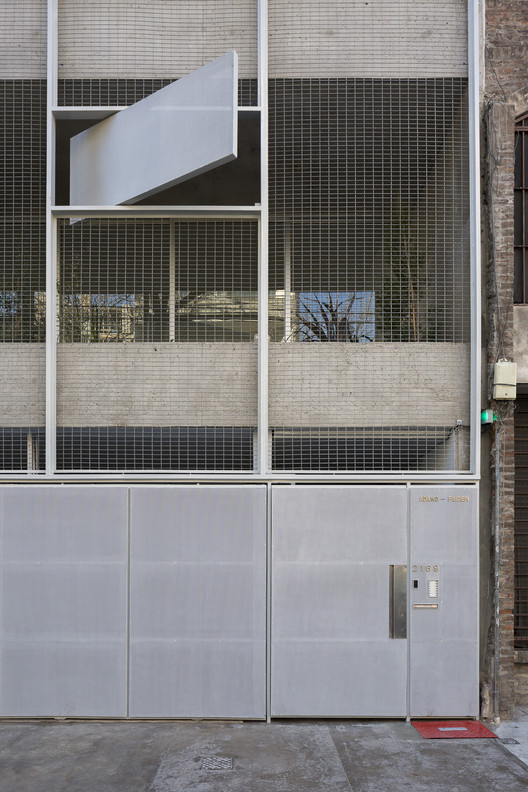Owls House estudio GonzaloGA
2018-11-18 09:00
© Luis Díaz Díaz
路易斯·迪亚斯·迪亚斯


背景:由一个新的拥有人获取了一个单一的家庭住宅(建于60年代),该房屋需要房屋的新功能。
BACKGROUND A single-family house (built in the 60’s) in a partial state of ruin is acquired by a new owner, who demands new functionalities for the house.
BACKGROUND A single-family house (built in the 60’s) in a partial state of ruin is acquired by a new owner, who demands new functionalities for the house.
© Luis Díaz Díaz
路易斯·迪亚斯·迪亚斯


最初的房子是为了容纳一个3人的家庭和一个服务者而设计的。新的房子配置应该包括一个4人的家庭,一个客人区,一个独立公寓,一个游乐场,以及把房子分成两个独立单元的可能性。
PROGRAM The original house was designed to accommodate a family of 3 members and a service person. The new configuration of the house should contain a family of 4 members, a guest area, an independent apartment, a playground and the possibility of dividing the house into two separate units.
PROGRAM The original house was designed to accommodate a family of 3 members and a service person. The new configuration of the house should contain a family of 4 members, a guest area, an independent apartment, a playground and the possibility of dividing the house into two separate units.
© Luis Díaz Díaz
路易斯·迪亚斯·迪亚斯


重建和重建房屋所带来的最大挑战是整合一个新的区域,在原有的足印中有更多的地表。由于房屋的局部破坏状况,有必要拆除原房屋的东部长方形机翼。新的建筑必须包含这一新的可用空间,并增加建造的米,以适应新的规划需要。空间配置是通过将程序的连续块(厨房、客厅、卧室和浴室)连在一起来开发的,其中包括一个L块,其中包含有独立访问的公寓。通过房屋的立面和屋顶所表示的体积,可以完成对这些块体的读取。
STRATEGY The biggest challenge posed by the reconstruction and rehabilitation of the house is the integration of a new area with more surface in the same pre-existing footprint. Due to the partial state of ruin, it is necessary to demolish the eastern rectangular wing of the original house. The new construction must contain this newly available space and multiply the built meters to accommodate the new programmatic needs. The spatial configuration is developed by concatenating successive blocks of the program (kitchen, living room, bedrooms, and bathroom) with the inclusion of an L block that houses an apartment with independent access. The reading of the blocks can be done through the volumetry expressed in the façade and roof of the house.
STRATEGY The biggest challenge posed by the reconstruction and rehabilitation of the house is the integration of a new area with more surface in the same pre-existing footprint. Due to the partial state of ruin, it is necessary to demolish the eastern rectangular wing of the original house. The new construction must contain this newly available space and multiply the built meters to accommodate the new programmatic needs. The spatial configuration is developed by concatenating successive blocks of the program (kitchen, living room, bedrooms, and bathroom) with the inclusion of an L block that houses an apartment with independent access. The reading of the blocks can be done through the volumetry expressed in the façade and roof of the house.
© Luis Díaz Díaz
路易斯·迪亚斯·迪亚斯


Elevations


© Luis Díaz Díaz
路易斯·迪亚斯·迪亚斯


战术,最臭名昭著的修改发生在重建的东翼,那里的高度加倍(使以前不存在的地下室),并重新配置,以适应新的程序。为了创造一个质量和功能的地下室,创造了一个热带英语露台,让光线到达地下室。整个较低楼层的玻璃信封提供光线,并有利于阅读连续空间,连接英国庭院和花园在房子的南部。
TACTICS The most notorious modification occurs in the reconstructed east wing where the height is doubled (enabling a previously non-existent basement) and reconfigures to accommodate the new program. With the intention of creating a quality and functional basement, a tropical English patio that allows light to reach the basement is created. The glass envelope throughout this lower floor provides light and favors the reading of the continuous space, connecting the English patio with the garden to the south of the house.
TACTICS The most notorious modification occurs in the reconstructed east wing where the height is doubled (enabling a previously non-existent basement) and reconfigures to accommodate the new program. With the intention of creating a quality and functional basement, a tropical English patio that allows light to reach the basement is created. The glass envelope throughout this lower floor provides light and favors the reading of the continuous space, connecting the English patio with the garden to the south of the house.
© Luis Díaz Díaz
路易斯·迪亚斯·迪亚斯


新的重建翼有一个正式和建设性的二元性,分享美学和类似的解决方案,以前的房子在整个北立面(到达房子),因为它是在这个地区的房子,你可以看到两个时代。该立面采用传统施工技术解决,实现了新旧构件的融合。另一方面,南面通过打开大窗户,利用景观和阳光,将传统建筑技术与现代建筑技术有机地结合在一起,解决了这一问题。
The new reconstructed wing has a formal and constructive duality, sharing aesthetics and similar solutions to the previous house in the entire north façade (arrival to the house) since it is in this area of the house where you can see both eras. This facade has been resolved with traditional construction techniques to achieve the integration of the new part with the old. On the other hand, the south façade takes advantage of the views and the sunlight by opening large windows, resolved with a constructive hybrid system between the traditional and contemporary construction techniques.
The new reconstructed wing has a formal and constructive duality, sharing aesthetics and similar solutions to the previous house in the entire north façade (arrival to the house) since it is in this area of the house where you can see both eras. This facade has been resolved with traditional construction techniques to achieve the integration of the new part with the old. On the other hand, the south façade takes advantage of the views and the sunlight by opening large windows, resolved with a constructive hybrid system between the traditional and contemporary construction techniques.
Ground Floor Plan


Upper Floor Plan
上层平面图


这座建筑的屋顶是由金属桁架构成的,其倾斜度在每个街区都是不同的。新屋顶的一部分是用旧瓷砖回收而成的,其余的则用类似于先前存在的平铺瓷砖完成,使原房屋的语言保持连续性。
The roof of the building is done with a structure of metal trusses whose inclinations vary in each block. Part of the new roof is made with the old tile recovered and the rest is completed with a flat tile similar to the preexisting, giving continuity to the language of the original house.
The roof of the building is done with a structure of metal trusses whose inclinations vary in each block. Part of the new roof is made with the old tile recovered and the rest is completed with a flat tile similar to the preexisting, giving continuity to the language of the original house.
© Luis Díaz Díaz
路易斯·迪亚斯·迪亚斯




© Luis Díaz Díaz
路易斯·迪亚斯·迪亚斯




















































Architects estudio GonzaloGA
Location Benahavís, Spain
Author Architects Gonzalo Gutierrez Araujo
Area 400.0 m2
Project Year 2017
Photographs Luis Díaz Díaz
Category Renovation
Manufacturers Loading...
























